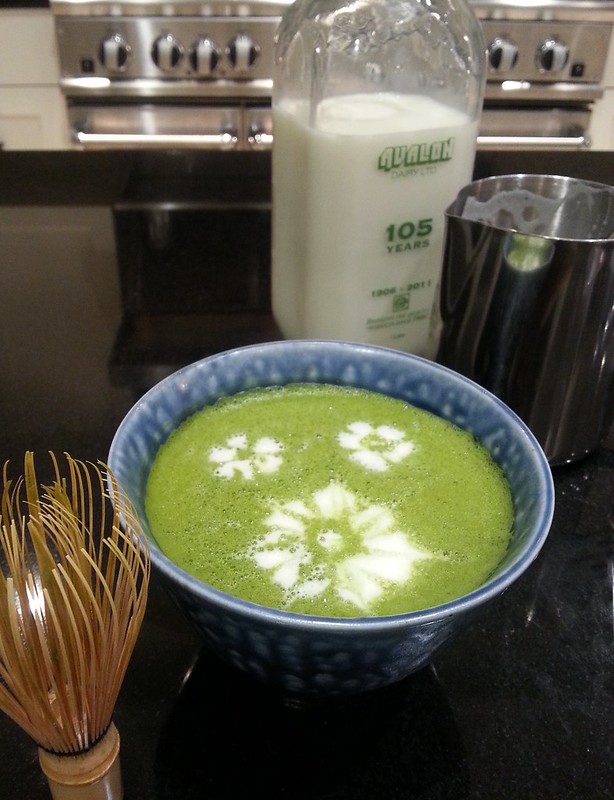
I took such a long time trying to set up my shots that my matcha latte started to settle. My etched flowers started to shrink and the drink had gotten cold! Food blogger problems.
TS:
For the past two to three weeks, I have noticed that the left side of my body has been unusually stiff and knotty: the trapezius, the lumbar, and who-knows-what-other muscles. I couldn't quite figure out why this could be. It was getting, and it still is, quite uncomfortable.
Then, finally, I realized what it was.
It's the blog! It's the blog!
I don't know why, as I do usually work at the computer anyway, but working on the blog specifically has resulted in stiff and tense muscles. This cannot go on.
To give myself time to recover, I decided that my second post-hiatus post should be a nice and easy one. A beverage post ought to do it.
(How many times can I write "post" in this post?)
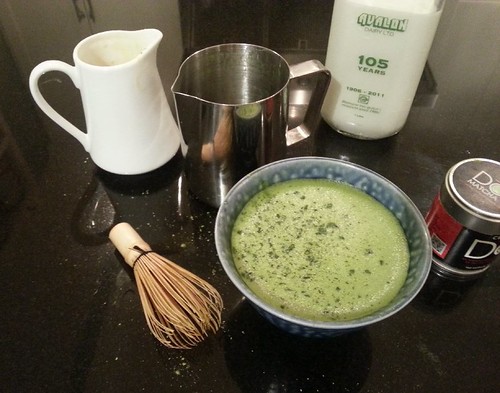
TS:
I don't usually drink a lot of milk, but I bought some Avalon milk one day and had to use it up. Avalon is a brand of organic milk sold in glass bottles. Just the glass bottle alone is reason enough for me to buy it, but one can actually taste the difference between this and the other conventional brands of milk sold here.
In simple terms, matcha is a green tea that is finely ground. To drink it, traditionally, one dissolves the matcha in hot water.
In recent years, matcha has gained popularity in North America not only as a beverage on its own and in latte incarnations, but also as flavoring in pastries and other food items.
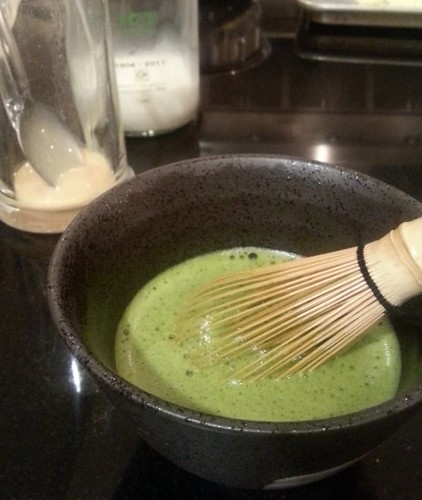
Dissolved matcha. In the background, condensed milk in a mug and my almost-empty Avalon milk bottle.
TS:
The first time I tasted green tea-flavored anything was way, way, way back when, upon recently arriving in Vancouver, a family friend took us to Baskin Robbins to try the green tea ice cream. Matcha and I go way back, as you can see.
More information about matcha later. Let's just make the drink.
Hot

My drink had gotten cold while I was taking pictures that I had to re-steam it, resulting in the more homogenous look above.
TS:
Dissolve matcha in hot water, preferably using a matcha whisk. Then, steam some milk and pour the steamed milk onto your dissolved matcha. (This assumes you have an espresso machine with a steam wand. If not, just heating the milk would work, but of course, one would lose the "sweetness" and additional body that steaming brings.)
From here, one can do a myriad of variations.
In my case, I tend to like my matcha latte just the teensiest bit sweet. One could just add sugar to the finished drink. Other sweetener choices include honey, agave, stevia, coconut sugar... One could even use white chocolate as sweetener! Just melt the chocolate and add to the drink. I can personally attest to the superb combination of matcha and white chocolate.
I used condensed milk in this version of matcha latte.
The choice of milk is also yours. There's cow's milk with different fat percentages. There's also soy milk, almond milk, goat milk, coconut milk, and all the other "milks" out there.
To make this particular version, I added the condensed milk to my 2% Avalon cow's milk and steamed the lot. I have tried using evaporated milk in the past, but it had too strong or rich a flavor.
When making the hot version, try to drink it in a timely manner. The matcha does tend to settle to the bottom.
An even easier version is to make your drink iced.
Iced
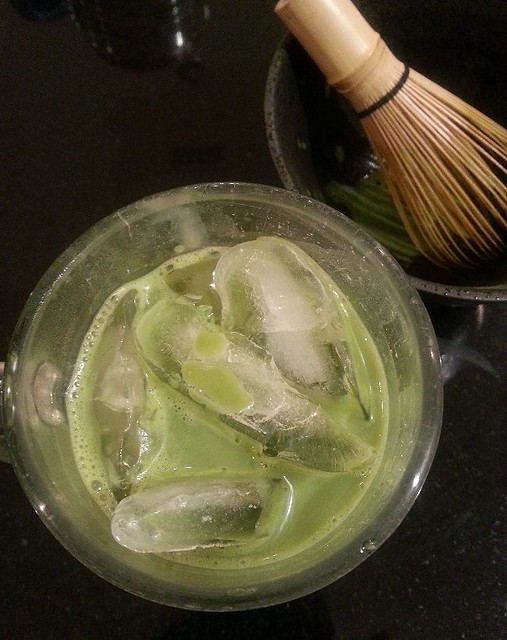
TS:
I quite liked the condensed milk + milk combination that I did the same thing for my iced matcha latte.
Once again, I dissolved matcha with hot water using my matcha whisk. I added the condensed milk to the matcha mixture and mixed well, then poured this over ice. I immediately topped up my drink with cow's milk ("immediately" as to prevent the hot matcha mixture from melting the ice too much).
Uh oh, I feel my left shoulder and back stiffening up. Perhaps I'll enlist JS to write about matcha.
Matcha

JS:
Matcha, for those not quite familiar with it, is tea powder made from ground tea leaves. You might think of matcha as a different way of drinking tea.
The "normal" or "usual" way of taking tea is to infuse the tea leaves in water -- what we drink as tea in this case is the water that has been flavoured by tea leaves.
With matcha, the whole tea leaf is ground it into fine powder. This powder is then whisked and dissolved in water. When we drink tea in this manner, we are actually ingesting the whole tea leaf.
I think that's all I'll say on the matter of the matcha -- or we will never finish this post. For more information, there's always Wikipedia.
Wikipedia: Matcha
TS:
When buying matcha, be sure to get pure matcha powder. There are some powder mixes that have matcha already blended with sugars, milk powders, and other ingredients or fillers. DoMatcha is quite readily available now. Aiya Matcha is also another brand I've tried. Both websites have more information about matcha.
JS:
Personally, my favourite matcha beverage preparation is TS' aforementioned matcha latte sweetened with a bit of white chocolate.
TS:
I've been on a beverage kick lately, and perhaps more beverage posts will pop up soon.
eatingclub Matcha
We also made Matcha Shortbread!
eatingclub vancouver Beverages, a selection
Matcha Latte (Japanese Green Tea Latte), Hot and Iced
Caffè Latte with Almond Milk
Cilantro Horchata
Salabat (Ginger Tea)
Turkish Çay (Turkish Tea)
Squash Churros with Orange-Sage Hot Chocolate
Avocado Shake
Recipe
Matcha Latte, Hot or Iced
Make your matcha latte according to your taste. Amounts are strictly suggestions only.
For one drink:
matcha (1 teaspoon to 1 tablespoon)
hot/boiling water (2 to 4 ounces; 50 to 125 mL)
choice of milk (4 to 8 ounces; 125 to 250 mL)
optional: sweetener
Hot
Warm your serving cup with hot water. Discard water.
In a small bowl, add matcha. Pour hot/boiling water into the bowl and whisk with matcha whisk using back and forth (not circular) motions. Make sure the matcha is completely dissolved.
Alternatively, one can use a small metal or silicone whisk or even a hand blender to dissolve the matcha in the water.
If using a sweetener, you can add it at this point.
Set aside.
Steam your choice of milk using a steam wand. Or, heat the milk on the stovetop or microwave, then use a milk frother to aerate the milk. One can also use a hand blender to aerate the milk. Try not to get big bubbles.
Pour dissolved matcha into your warmed serving cup. Pour steamed milk over the mixture.
Iced
Add desired amount of ice into your serving glass.
In a small bowl, add matcha. Pour hot/boiling water into the bowl and whisk with matcha whisk using back and forth (not circular) motions. Make sure the matcha is completely dissolved. Try to use as little amount of hot water as possible to dissolve your matcha.
Alternatively, one can use a small metal or silicone whisk or even a hand blender to dissolve the matcha in the water.
If using a sweetener, you can add it at this point.
Add the milk to your serving glass first, then pour in the dissolved matcha. Adding the cold milk first prevents the hot matcha mixture from melting the ice.
Enjoy!
Friday, January 31, 2014
Matcha Latte (Japanese Green Tea Latte), Hot and Iced
Tuesday, January 28, 2014
"Like" us!
Well, lookee here: we now have a facebook page! Please spare a moment to like us on Facebook. Thank you kindly.
eatingclub vancouver fb page
Friday, January 24, 2014
Water Boil Fish (水煮魚) or Water Boil Beef (水煮牛肉)

TS:
I realize I still have quite the backlog of pictures yet to be blogged... from 2010. With the start of the new year, I thought, "Why don't I just start posting?"
So, here I am.

Fuchsia translates this dish as "Boiled Beef Slices in a Fiery Sauce"
TS:
I have been looking through these old photographs with a sense of yearning. Oh, to be able to devote time to our cooking projects of yore! Oh, to satiate our stomachs and souls with simple, quotidian meals!
(Dramatic, much?)
It's been a while since JS and I have cooked on a regular basis; we've only been cooking for special occasions or gatherings. Isn't that sad?
But, no more. Maybe this is what they call a New Year's Resolution? Let's just see if it sticks.

TS:
First post of 2014 is "Water Boil".
We attempted this dish 3 times. First time with beef, then the latter two with fish. We were determined to follow the recipe through faithfully the first time, but, man, I don't know what Fuchsia was thinking.
I'm getting ahead, though. Let's start from the beginning.
v.1 Water Boil Beef

TS:
Since "Water Boil" is Sichuan, we thought we'd look to Fuchsia Dunlop's Land of Plenty: A Treasury of Authentic Sichuan Cooking. It seems we have used her Hunan book more than the Sichuan -- here, here, here and here. So perhaps we should even it out between the two books.
We got our stuff ready, like the good recipe-followers that we are. (People who know us would find that statement funny.) We prepped the celery and green onions. We sliced the beef and marinated the slices in Shaoxing wine and salt.
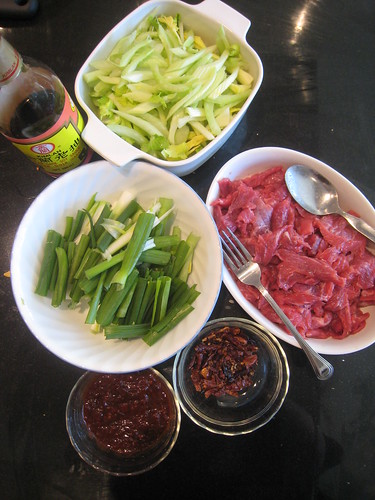
TS:
We cooked the prescribed amount of Sichuan peppercorns and dried chiles in oil, then chopped them. We left the now-fragrant oil in the wok and used that to cook the green onions and celery.

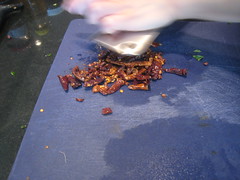



I love stir-fried celery! I used to hate celery because it was always being peddled to me raw. After trying them cooked and loving cooked celery, I have finally learned to not mind the raw.
TS:
So far, so good.
It's now douban time!
Wikipedia: Doubanjiang 豆瓣醬
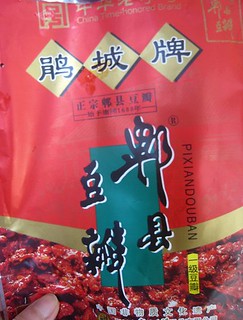
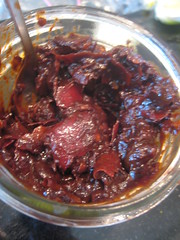
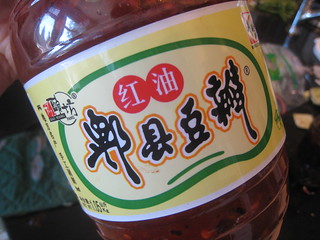
The douban above are both Pixian doubanjiang (郫县豆瓣酱).
TS:
The prescribed amount of doubanjiang (豆瓣醬) is cooked briefly in oil before the stock joins in. We seasoned the flavored liquid with soy sauce and salt, and brought it to a boil as instructed. We then turned our attention to the beef.
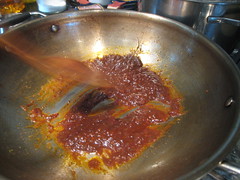
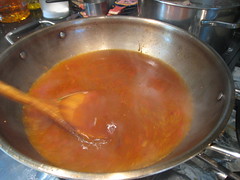

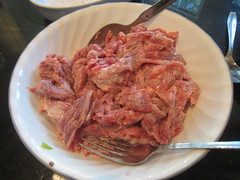
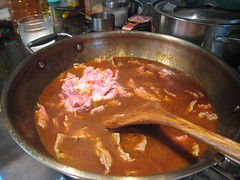
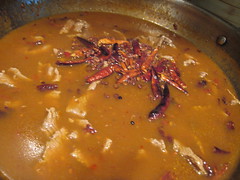
TS:
What there? We are to add a slurry made with six tablespoons of cornstarch to the beef?
O... K... If you say so?
We added the beef to the boiling liquid and waited until the slices were cooked. Then the lot was added to the patiently waiting vegetables. Oh yes, the chopped Sichuan peppercorns and dried chiles were added to the finished dish.
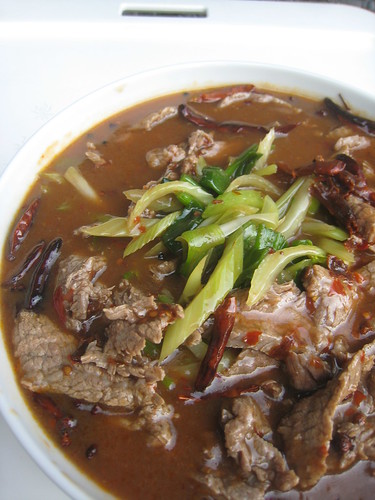
Meh.
JS:
We were not thoroughly satisfied with the water-boiled beef -- there was just something lacking from it; it didn't quite have lustre.
TS:
The something lacking was taste! I don't know how Fuchsia made a dish that had doubanjiang and Sichuan peppercorns, among other things, so bland! She seems quite shy with flavor.
We should've known. We had the same issue making her Ma Po Tofu.
Besides the overall blandness of the dish, the broth (or "water") also took on a disturbing viscosity. It was unnecessarily thick from the cornstarch slurry, not to mention the slurry giving the "water" a browner color than the red we were used to. And oh yeah, there was no chile oil!
Fuchsia, Fuchsia, Fuchsia. [sigh]
JS:
Disturbing -- yes, that's one way of putting it. Beef in brown sludge. We figured we would change proteins. Maybe the beef overpowered and didn't play nice with the other ingredients of the dish?
Or, we have always ordered Water Boil with fish in restaurants. We'll try that, we thought.
v.2 Water Boil Fish
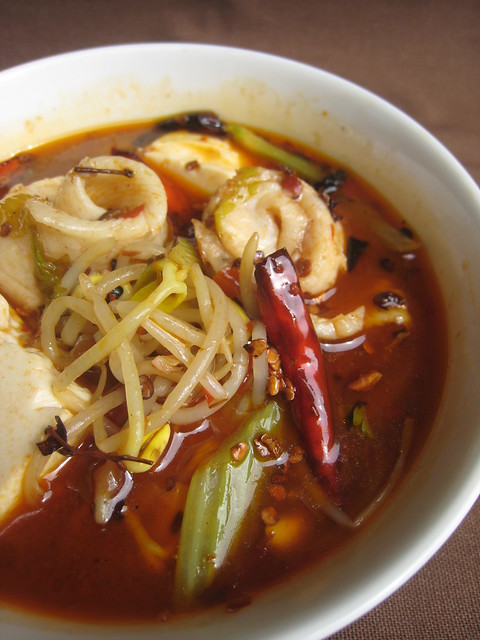
JS:
We chose a delicate fish the second time around. Sole. It was so delicate that TS had to roll them up to prevent them from disintegrating into the broth.
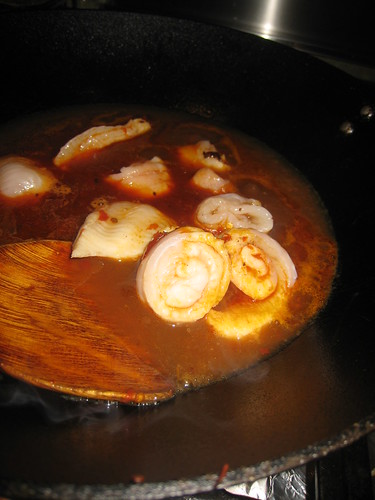
TS:
We also added soybean sprouts into the mix. We have always encountered soybean sprouts in restaurant versions and I love them!
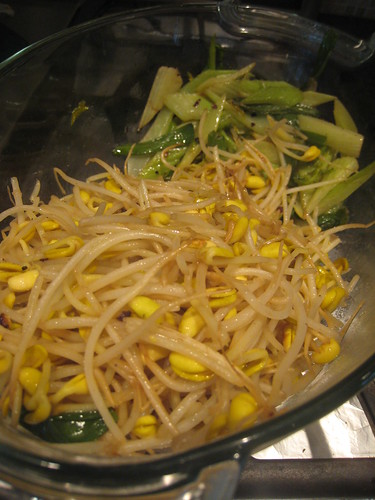
TS:
Besides the soybean sprouts -- totally legit -- we also added tofu (soft, in this case). I haven't seen tofu added to water boil, but it seemed to make perfect sense to us. ;)
Needless to say, we also upped the amounts of all flavorful ingredients in the recipe: Sichuan peppercorns, dried chiles, douban paste. We also dispensed with the cornstarch slurry as it's not applicable to cooking the fish.
To be authentic, fish slices should be coated with beaten egg whites then fried before being added to the broth. You may or may not remember that we suffer from a serious lack of industry and hence, obviously, we did not bother with that step. Our fish slices were au naturel.
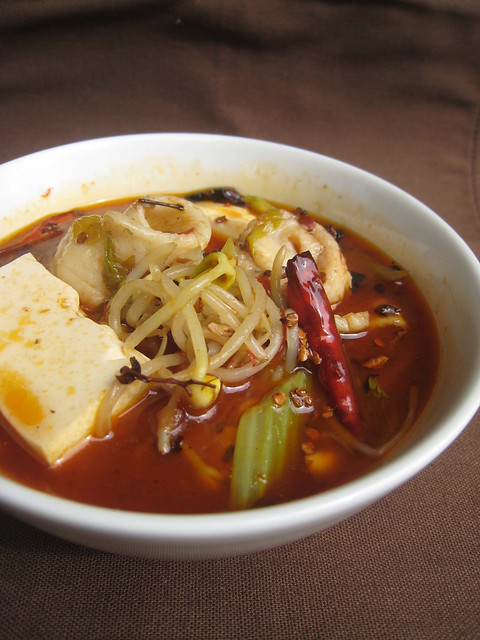
JS:
There was still something not quite there yet. We were scratching our heads after this. We were still following Fuchsia's recipe, more or less. Are we reading the recipe wrong?
TS:
I find Fuchsia's recipe a bit clunky. Reading it now, it seems... well, clunky. But, I suppose we needed a starting point.
JS:
The dish was just not coming together: call it a lack of vision. It didn't seem to know that it was supposed to be. I tasted disparate ingredients but not the whole dish.
TS:
Don't get us wrong, version 2 was definitely worlds better than version 1. It was actually some tasty eating! Imagine that douban-y broth, the sautéed soybean sprouts and celery, the delicate fish, the numbing Sichuan peppercorns, even the silky-textured tofu...
But, somehow (some day! somewhere!), it was not all it could be. It was falling short of its fiery potential.
What could it be?
v.3 Water Boil Fish
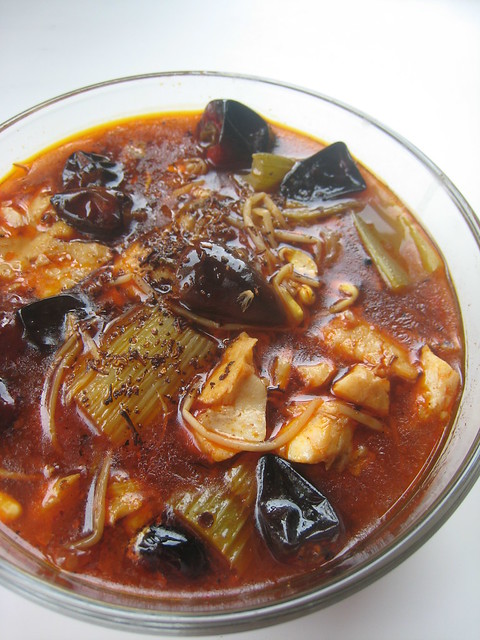
TS:
So, what to do now?
JS:
Very much against our very lazy natures, we figured we'd give this dish another go. We made it a third time.
We came across these bulbous chile peppers one time while shopping. I think these are called facing-heaven chile. We had made some chili oil using these peppers fairly recently and they do indeed have quite a distinctive aroma and taste.
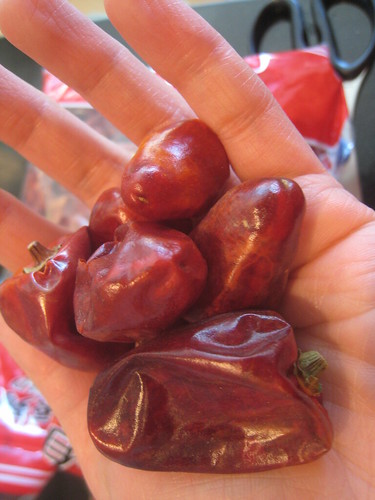
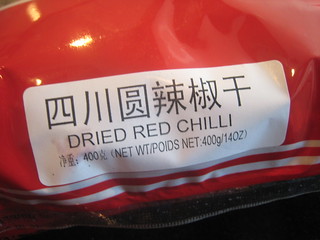
What "facing-heaven"? The Chinese label just says "Sichuan Round Dried Chili Peppers", man.
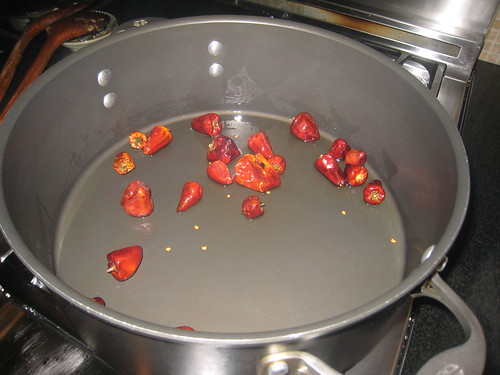
JS:
Hmm. Could it be?
Yes, it could be the -- or, a -- missing ingredient. It had the word Sichuan in the name, so I figure maybe we needed some of them in the broth to achieve that Sichuan taste.
I got some snapper fillets this time and proceeded to repeat the recipe.
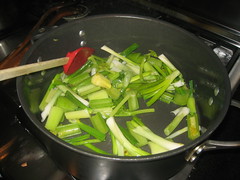
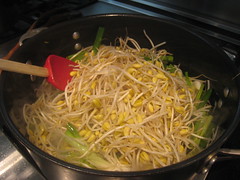

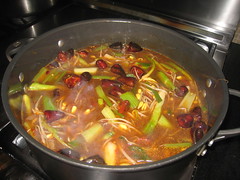
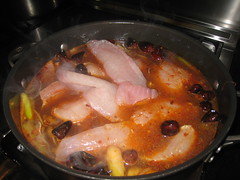

JS:
I sautéed the facing-heaven peppers in some oil to infuse the oil with their aroma. Then, I proceeded with the vegetable cookery. The douban paste and everybody else joined the party. Of course, there's the Sichuan peppercorns cooked in oil too.

The "water" and the oil floating on top. Pretty.
JS:
Are we there yet?
Not quite yet, something's still missing from the dish.
I'm thinking... there might be something we can do to make this more flavourful.
Water Boils in our lives

Water Boil Fish at Dinesty, circa 2014
Why yes, I ordered Deep-fried Silver Thread Buns for dipping into condensed milk. CONDENSED MILK! Mmmm.
JS:
Fast forward three years later...
TS:
Make that four years later... it's 2014 now.
JS:
We were at a newly-opened location of a popular restaurant where we ordered their version of water-boiled fish for lunch. When the dish came to our table, it was quite fragrant -- with GARLIC!
Maybe garlic was the missing ingredient.
TS:
They had slices of garlic in the broth, as well as a whack of briefly-cooked minced garlic on top!
My, oh, my, GARLIC, of course! We love garlic! Like black pepper, I tend to think of garlic as a neutral flavor. ;)
Bomb that water boil with garlic! Of course!


left: Water Boil at Peaceful Restaurant, circa 2012
right: Water Boil at Golden Spring Restaurant, circa 2012
TS:
And poking around the interwebs the past week, as well as looking back to the Water Boils we have tried in restaurants, I gathered some more flavor-enhancing ideas. I don't know why we didn't think of this when we were actually making the dish. I guess we had blinders on back then. We were quite new to the whole Sichuan thing. Ah, to be so young and innocent.
Below is the version we had in 2010 at Alvin Garden. I still remember that this was a really good version.

Water Boil at Alvin Garden, circa 2010
Photo courtesy of Chowtimes.com
TS:
See, look at these different versions. Besides garlic, we should've added Sichuan dried chili flakes, the same we used to make our Red Chile Oil (紅油). Cilantro, too. I've even seen some recipes that added just a tad more spicing by way of one lone star anise or cinnamon bark, or a touch of cumin. All very promising ideas, indeed.
And of course, one mustn't forget to drown the thing with chile oil -- which, of course, we did forget those 3 times in 2010.
So, it being 2014, I think we should be ready for version 4, right?
P.S.
There! We managed to pump a post out! I had a grand delusional vision of overhauling the blog's look too, but after a few hours dealing with various templates and trying to customize them, I gave up. At least for now. Posting at all is a victory in itself. ;D
eatingclub Sichuan/Sichuan-inspired (Szechuan)
Red Chile Oil (紅油)
Sichuan Peppercorn Chili Oil
Spicy Sweet Sichuan Popcorn
Gong Bao ("Kung Pao") Chicken (宮保雞丁)
Eggplant Dandan Mian (擔擔麵)
Sichuan "Crossed Hands" Wonton Dumplings 抄手, Two Ways (in Broth and with Chili Oil Sauce)
Sichuan Ma Po Tofu (麻婆豆腐)
Water Boil Fish (水煮魚) or Water Boil Beef (水煮牛肉)

Enjoyed this post? Why not subscribe to our blog? Subscribe via reader or subscribe via email. Thank you! |
Recipe
Water Boil Beef (水煮牛肉)
from Fuchsia Dunlop's Land of Plenty: A Treasury of Authentic Sichuan Cooking
Our notes in italics and colored.
Serves 2 as a main dish, 4 with rice and two to three other dishes
1 head celery (about 1 pound)
use soybean sprouts too
2 scallions, white and green parts add more if you wish
garlic, sliced and/or minced
a handful of dried chiles (8-10)
more dried chiles wouldn't hurt; these are the long thin chiles
one could also add the round chiles
about 1 pound lean beef (flank steak is good)
we like fish better than beef; either have them in biggish pieces, or thinly-sliced
salt
1 tablespoon Shaoxing rice wine
about 1/3 cup peanut oil
2 teaspoons Sichuan pepper (花椒)
3 tablespoons chili bean paste (doubanjiang, 豆瓣醬)
be more generous with both the Sichuan peppercorns and doubanjiang
3 cups everyday stock or chicken stock
2 teaspoons dark soy sauce
4 tablespoons potato flour mixed with 4 tablespoons cold water, or 6 tablespoons cornstarch mixed with 6 tablespoons cold water if using a slurry, use less
other "topping" ingredients:
red chile oil and/or Sichuan pepper oil
cilantro
minced garlic, sautéed in oil
Sichuan dried chile flakes
Clean and remove the fibrous outer edge of the celery stalks. Chop each stalk into 3 or 4 sections, then slice these lengthwise into 1/2-inch sticks.
Gently crush the scallions and chop them into 3 sections to match the celery stick.
Wearing rubber gloves, snip the chiles in half, discarding as many seeds as possible.
Remove any fat from the beef and cut it, against the grain, into thin slices about 1 inch by 2 inches (you should have about 3/4 pound of beef after trimming). Add 1/4 teaspoon salt and the Shaoxing rice wine, mix well, and leave to marinate while you prepare everything else.
If using fish, beat an egg white and add that to the fish. Also add the marinade ingredients: salt, Shaoxing wine. Fry the coated fish pieces in oil and set aside.
Heat 3 tablespoons of oil in a wok until hot but not yet smoking. Add the chiles and Sichuan pepper and stir-fry until they are fragrant and the chiles are just beginning to brown (take care not to burn them). Then immediately slide the spices out into a bowl, leaving the oil in the wok. When they have cooled down a little, move them onto a cutting board and chop them finely with a gentle rocking motion, using a cleaver taken in both hands or a two-handled chopper. Set them aside to use later.
Return the oily wok to the stove and heat over a high flame. When it is smoking, add the vegetables and stir-fry for a minute or two, adding 1/4-1/2 teaspoon of salt to taste, until they are hot and just-cooked but still crunchy. Then pour them into the serving bowl.
Heat another 3 tablespoons of oil in the wok over a high flame, until just beginning to smoke. Turn the heat down to medium, add in the chili bean paste (and sliced/minced garlic, if using), and stir-fry for about 30 seconds, until the oil is red and fragrant. Add the stock and the dark soy sauce, season to taste with salt, and return to a boil over a high flame.
Then, add the potato flour or cornstarch mixture to the beef and stir well in one direction to coat all the pieces. When the sauce is boiling vigorously, drop in the beef slices. Wait for the sauce to return to a boil and then use a pair of chopsticks to gently separate the slices. Simmer for a minute or so, until the beef is just cooked, and then spoon it onto the waiting vegetables. Pour over the sauce.
Swiftly rinse out the wok and dry it well. Heat another 3-4 tablespoons of oil in the wok until smoking. Sprinkle the chopped chiles and Sichuan pepper over the beef dish and then pour over the smoking oil, which will sizzle dramatically. If you move quickly, the dish will still be fizzing when you bring it to the table.
When the dish has been assembled -- broth, vegetables, and protein -- add your "toppings": chile oil(s), minced garlic, cilantro, dried Sichuan red chile flakes, more sautéed Sichuan peppercorns...
(This recipe is really poorly written.)





